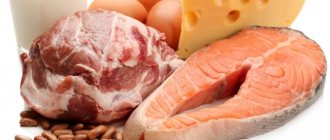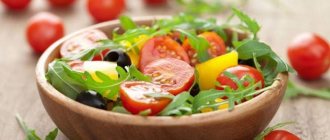The path that food takes from entering the body to leaving the body is long and winding. To ensure that a person receives all the necessary nutrients, a processing plant called the “Gastrointestinal Tract” works tirelessly inside him. Remember the common phrase: “There are no irreplaceable people”? So this one is not about the digestive system. Every element is important here, and there is no alternative to any. In this article we tell you how the gastrointestinal tract works so that the food from your plate turns into “molecules of life”.
The structure of the digestive system
To understand what digestion is, it is necessary to consider the structure and functions of the digestive system.
It consists of organs and departments:
- oral cavity and salivary glands;
- pharynx;
- esophagus;
- stomach;
- small intestine;
- colon;
- liver;
- pancreas.
The listed organs are structurally interconnected and represent a kind of tube, 7–9 meters long. But the organs are laid out so compactly that with the help of loops and bends they are located from the oral cavity to the anus.
Interesting! Failures in the digestive system lead to various diseases. To ensure proper digestion, give up poor nutrition, fatty foods, and strict diets. Also, the organs are adversely affected by poor ecology, regular stress, alcohol and smoking.
The main function of the digestive process is to digest food and gradually process it in the body to form nutrients that are absorbed into the lymph and blood.
But besides this, digestion performs a number of other important tasks:
- motor or motor is responsible for grinding food, mixing with the secretions of the digestive glands and further movement through the gastrointestinal tract;
- secretory ensures the breakdown of nutritional components into mucous membranes, electrolytes, monomers and final metabolic products;
- absorption promotes the movement of nutrients from the tract cavity into the blood and lymph;
- protective consists of creating barriers using the mucous membrane;
- excretory removes toxic substances from the bodyalign: justify;»> Digestion is the process of chemical and mechanical processing of food, during which it is digested and absorbed by the cells of the body. Digestive pigments process incoming food and break it down into complex and simple food components. First, proteins, fats and carbohydrates are formed in the body, which in turn become amino acids, glycerol and fatty acids, monosaccharides.
The components are absorbed into the blood and tissues, contributing to the further synthesis of complex organic substances necessary for the proper functioning of the body. Digestive processes are important for the body for energy purposes. Due to the digestion process, calories are extracted from food, which improve the functioning of internal organs, muscles, and the central nervous system. The digestive system is a complex mechanism that involves the human mouth, stomach and intestines. If foods are not digested correctly and minerals remain unchanged, it will not benefit the body. In a healthy person, all stages of the digestion process last for 24 to 36 hours. Let's study the physiology and features of the digestive process in order to understand how the human body works.
The way of the apple: what happens to food when it enters our body - Meduza
Go to materials
Affiliate Material
Digestion is a complex process (according to some sources, it lasts more than 50 hours).
Food needs to travel a long way (about 9 meters) to provide the body with energy and all the necessary nutrients. And along the way, anything happens - food is broken down, sorted and processed.
Together we tell you how the digestive system works and what happens to food at each stage.
Yes, as soon as a piece of food, for example an apple, ends up in your mouth, the salivary glands located there begin to actively secrete saliva. It envelops food, making it softer and more uniform.
In addition, saliva contains enzymes - they help break down nutrients into simple compounds (in the mouth this begins to happen with fats and carbohydrates). Sometimes saliva is produced even before a person starts eating.
It's all about the nerve endings that connect the central nervous system with the digestive system. For example, when a person sees or smells an appetizing dish, his brain sends a signal that causes the salivary glands to “get ready” for food and secrete saliva.
Also no less actively involved in the process are the teeth, which grind food, and the tongue, which mixes it with saliva. And thanks to receptors on the surface of the tongue, the brain recognizes and distinguishes the taste of the food we eat.
Chopped, soft food (bolus) can now be swallowed. This is where the tongue (again) and the epiglottis come into play. The first pushes food further along the digestive tract, and the second prevents it from entering the respiratory tract.
Next, the food enters the esophagus, a tube that connects the mouth and stomach. The muscles in the wall of the esophagus, contracting, move the apple further.
These wave-like contractions are called peristalsis, and they occur not only in the esophagus, but also in the stomach and intestines. If everything is normal, a person does not feel these waves - our digestive tract works autonomously.
When the bolus reaches the lower part of the esophagus, the sphincter (also known as the valve that separates the esophagus from the stomach) relaxes and food enters the stomach.
There, thanks to active and powerful contractions of the stomach muscles, food is crushed even more and mixed with digestive (stomach) juice.
It consists of hydrochloric acid, water and such an important enzyme as pepsin, which is responsible for the breakdown of proteins. At the same time, the caustic gastric juice does not harm the stomach in any way - its walls are covered with a reliable protective layer.
As a result of all manipulations, chyme is formed - this is partially digested food, more liquid than solid.
When the chyme is thoroughly saturated with digestive juice, waves of muscle contractions propel it through another valve (pyloric sphincter) into the small intestine, namely at its very beginning - the duodenum.
There, digestive juices come into play, which are produced by the pancreas, liver and gall bladder. The duodenum produces a large amount of mucus to protect its walls from the acids contained in the chyme.
The pancreas produces some hormones (including insulin), as well as amylase, lipases and proteases - enzymes that break down carbohydrates, fats and proteins. The liver synthesizes bile, which helps absorb fatty acids.
Bile ducts carry bile from the liver to the gallbladder (where it is stored) or the duodenum (where it is used). But this, of course, is not the only function of the liver - in its laboratory important chemicals are produced, thanks to which our body functions.
For example, it converts amino acids into each other, synthesizes various fats and stores vitamins and carbohydrates (in the form of glycogen). In addition, the liver neutralizes dangerous and harmful substances.
Just in the small intestine. Through millions of tiny villi that form the walls of the intestine, nutrients enter the bloodstream (fat-soluble substances are first absorbed into the lymph and only then enter the bloodstream).
The blood carries them throughout the body, for example, carrying simple sugars, amino acids, glycerol, some vitamins and salts to the liver, which stores, processes them and, when necessary, delivers them to where they are needed. The main absorption of water occurs there, in the small intestine.
What remains of food when it passes through the rest of the intestine—the jejunum and ileum—is a mixture of water, electrolytes, and various undigested elements (such as plant fibers). All this passes into the large intestine.
Yes. Bacteria in the colon help break down remaining nutrients and also synthesize some vitamin K. There, water is absorbed from leftover food and feces are formed, which then move to the last part of the intestine - the rectum. As a result of muscle contractions, bowel movement occurs.
The digestion process requires a lot of energy. The body spends approximately 10% of all calories from carbohydrates and proteins to ensure that food travels such a long way and the beneficial substances it contains are absorbed.
Sometimes disruptions occur in the digestive system: the stomach hurts, bloating, cramps (painful contractions of the intestines) occur, and stool becomes irregular. In such cases, an antispasmodic can help.
For example, the drug “Neobutin®”, together with the manufacturer of which we made this material.
"Neobutin®" acts throughout the gastrointestinal tract and regulates the activity of neurons - due to this, spasms that cause pain and bloating disappear, and intestinal motility is restored - and, as a result, stool becomes regular again.
There are contraindications, it is necessary to consult a specialist.
Affiliate Material
Source: https://meduza.io/slides/put-yabloka-chto-proishodit-s-edoy-kogda-ona-popadaet-k-nam-v-organizm
The structure of the digestive system
To understand what digestion is, it is necessary to consider the structure and functions of the digestive system.
It consists of organs and departments:
- oral cavity and salivary glands;
- pharynx;
- esophagus;
- stomach;
- small intestine;
- colon;
- liver;
- pancreas.
The listed organs are structurally interconnected and represent a kind of tube, 7–9 meters long. But the organs are laid out so compactly that with the help of loops and bends they are located from the oral cavity to the anus.
Interesting! Failures in the digestive system lead to various diseases. To ensure proper digestion, give up poor nutrition, fatty foods, and strict diets. Also, the organs are adversely affected by poor ecology, regular stress, alcohol and smoking.
The main function of the digestive process is to digest food and gradually process it in the body to form nutrients that are absorbed into the lymph and blood.
But besides this, digestion performs a number of other important tasks:
- motor or motor is responsible for grinding food, mixing with the secretions of the digestive glands and further movement through the gastrointestinal tract;
- secretory ensures the breakdown of nutritional components into mucous membranes, electrolytes, monomers and final metabolic products;
- absorption promotes the movement of nutrients from the tract cavity into the blood and lymph;
- protective consists of creating barriers using the mucous membrane;
- excretory removes toxic substances and foreign bodies from the body;
- endocrine produces biologically active substances to regulate digestive functions;
- Vitamin-forming ensures the production of vitamins B and K.
Digestive functions include sensory, motor, secretory and absorption. Among non-digestive tasks, scientists distinguish protective, metabolic, excretory and endocrine.
How does food move through the gastrointestinal tract?
The large, hollow organs of the gastrointestinal tract—the stomach and intestines—have a layer of muscle that moves their walls. This movement allows food and liquid to move through the digestive system and mix.
Contraction of the organs of the gastrointestinal tract is called peristalsis.
. It looks like a wave that moves along the entire digestive tract with the help of muscles.
The intestinal muscles create a constricted area that slowly moves forward, pushing food and liquid in front of it.
Features of the digestion process in the oral cavity
The stages of human digestion in the oral cavity, where the grinding of food for further processing begins, are important processes. Products interact with saliva, microorganisms and enzymes, after which the taste of food appears and starchy substances are broken down into sugars. The processing process involves teeth and tongue. During coordinated swallowing, the uvula and palate are involved. They prevent food from entering the epiglottis and nasal cavity. The body analyzes incoming food, softens and grinds it. After this, it enters the stomach through the esophagus.
Digestive processes in the stomach
The stomach is located in the human body in the left hypochondrium under the diaphragm and is protected by three membranes: external, muscular and internal. The main function of the stomach is to digest food due to the abundant shunting of blood vessels and arteries by capillaries. It is the widest part of the digestive tract and can expand in size to absorb large amounts of food. During the processing of food in the stomach, the walls and muscles contract, after which it mixes with gastric juice. The process of chemical and mechanical treatment in the stomach lasts for 3 to 5 hours. Food is affected by hydrochloric acid, which is contained in gastric juice and pepsin.

Following the logical flow of the digestion process, proteins are processed into amino acids and low molecular weight peptides. Carbohydrates in the stomach stop being digested, so amylases lose their activity in an acidic environment. In the stomach cavity, due to hydrochloric acid, proteins swell and also provide a bactericidal effect. The peculiarity of the gastric digestion process is that foods rich in carbohydrates are processed briefly and after 2 hours they move on to the next process. Proteins and fats remain in the compartment for up to 8 – 10 hours.
Stages of digestion. Absorption of nutrients into the blood - a lesson. Biology, Human (8th grade)
Digestion in the mouth
When chewing food, a person moves it in the oral cavity using the tongue (with the help of whose receptors we sense the taste, mechanical properties and temperature of food). The oral cavity contains teeth necessary for mechanically grinding food during chewing. The more thoroughly food is crushed in the mouth, the better prepared it is to be processed by digestive enzymes.
In the mouth, food is moistened with saliva, which is secreted by the salivary glands. Saliva consists of \(98\)–\(99\)% water.
Saliva contains:
- enzymes that break down complex carbohydrates into simple carbohydrates (for example, the enzyme ptyalin breaks down starch into an intermediate product, which another enzyme, maltase, converts into glucose).
- substance mucin , which makes the food bolus slippery;
- lysozyme is a bactericidal substance that partially disinfects food from bacteria entering the oral cavity and heals damage to the oral mucosa.
Poorly chewed food impedes the functioning of the digestive glands and contributes to the development of stomach diseases.
From the oral cavity, the food bolus passes into the pharynx and then is pushed into the esophagus.
Food moves through the esophagus thanks to its peristalsis - wave-like contractions of the muscles of the wall of the esophagus.
Mucus, which is produced by the glands of the esophagus, facilitates the passage of food.
Digestion in the stomach
Proteins and some fats (for example, milk fat) begin to be digested in the stomach.
For some time, salivary enzymes continue to act in the food bolus, digesting sugars, and then the food bolus is saturated with gastric juice, and proteins are digested in it under the influence of gastric juice.
An important feature and condition for effective digestion in the stomach is an acidic environment (since gastric juice enzymes act on proteins only at body temperature and in an acidic environment).
Gastric juice is acidic. The hydrochloric acid included in its composition activates the enzyme of gastric juice - pepsin , causes swelling and denaturation (destruction) of proteins and promotes their subsequent breakdown into amino acids.
During the digestion of food, the walls of the stomach slowly contract (gastric peristalsis), mixing food with gastric juice.
Depending on the composition and volume of food eaten, its stay in the stomach lasts from \(3\) to \(10\) hours. After processing the gastric juice enzymes, food masses pass in portions from the stomach into the duodenum (the initial section of the small intestine) through an opening surrounded by sphincters.
Digestion in the small intestine
The most important processes of food digestion occur in the duodenum. Digestion occurs both in the intestinal cavity (cavitary) and on cell membranes (parietal), which form a huge number of villi lining the small intestine.
In the duodenum, food is affected by:
- enzymes of the juice of the intestinal walls (intestinal juice),
- pancreatic enzymes (pancreatic, or pancreatic, juice);
- bile (produced by the liver ).
In the small intestine, the breakdown of nutrients into simple compounds continues (proteins into amino acids, fats into glycerol and fatty acids, carbohydrates into glucose) and their absorption into the blood and lymph.
The surface of the small intestine is covered with villi, of which there are so many (\(2500\) villi per \(1\) cm²) that the surface appears velvety. Villi increase the total absorption surface (the total surface of villi in the intestine reaches \(200\) m²).
The walls of the villi consist of a single layer of epithelium, and in the center of each villi there are lymphatic capillaries and blood capillaries. The products of fat processing enter the lymph, and amino acids and simple carbohydrates enter the blood.
A feature and condition for effective digestion in the intestines is a slightly alkaline environment .
The intestinal walls constantly contract, moving food masses through the intestines and mixing them. Peristalsis of the small intestine ensures the movement of food to the large intestine. Between the small and large intestines there is a special valve (sphincter), which allows food masses to pass in portions and only in one direction.
During meals (when a new portion of food enters the stomach and it is necessary to free up space in the large intestine), the walls of the colon contract intensely, pushing the contents into the rectum.
The feces that enter the rectum consist of \(70\)% water, and the rest is the remains of undigested food (mainly fiber).
Water and fiber breakdown products are absorbed in the large intestine. Symbiont bacteria that live in the human large intestine perform a number of functions - fermentation of fiber, synthesis of vitamins K and B.
The movement of food debris through the large intestine takes approximately \(12\) hours. During this time, partial absorption of water and dissolved substances occurs. The glands of the colon produce juice that does not contain enzymes, but contains mucus necessary for the formation of feces. Feces accumulate in the rectum and are removed through the anus.
Sources:
Lyubimova Z. V., Marinova K. V. Biology. Man and his health. 8th grade. — M.: Vlados.
Lerner G.I. Biology: A complete reference book for preparing for the Unified State Exam: AST, Astrel.
https://school-collection.edu.ru
Source: https://www.yaklass.ru/p/biologia/chelovek/pishchevaritelnaia-sistema-16033/etapy-pishchevareniia-16079/re-8d792070-b980-4368-85a7-f94f7e792130
How does digestion occur in the small intestine?
Partially digested food, along with gastric juice, moves in small portions into the small intestine. This is where more important digestive cycles take place. Intestinal juice consists of an alkaline environment due to the intake of bile, secretions of the intestinal walls and pancreatic juice. The digestion process in the intestines may slow down due to a lack of lactase, which hydrolyzes milk sugar. More than 20 enzymes are consumed in the small intestine as a result of the digestion process. The work of the small intestine depends on the uninterrupted functioning of three sections that smoothly transform into each other: the duodenum, jejunum and ileum.
Liver functions
It should be noted the invaluable role of the liver, which produces bile during the digestion process. The work of the small intestine would not be complete without bile, as it helps emulsify fats, activate lipases and absorb triglycerides into the stomach. Bile stimulates perilstatics, enhances the absorption of proteins and carbohydrates, increases hydrolysis and promotes the inactivation of pepsin. Bile plays an important role in the absorption and dissolution of fats and fat-soluble vitamins. If there is not enough bile in the body or it is secreted into the intestines, then the digestive processes are disrupted, and fats are released in their original form when feces are released.
Importance of the Gall Bladder
In the gallbladder of a healthy person, reserves of bile are deposited, which the body uses when processing a large volume. The need for bile disappears after the duodenum is empty. But the liver's work does not stop when food is eliminated. It produces bile, storing it in the gallbladder so that it does not spoil and is stored until the need for it arises again.
If the gallbladder is removed from the body for some reason, its absence is easily tolerated. Bile is stored in the bile ducts and from there it is easily and continuously sent to the duodenum, regardless of the fact of food intake. Therefore, after surgery, you need to eat often and in small portions so that there is enough bile to process it. This is due to the fact that there is no more space to store leftovers, which means that the reserve stock is extremely small.
What can cause disruptions in the gastrointestinal tract?
A person’s general well-being largely depends on the functioning of his gastrointestinal tract
, various diseases of the stomach and gallbladder can disrupt this work, but the person himself can harm himself.
Frequent “man-made” causes of disturbances in the functioning of the stomach
are:
- smoking and alcohol abuse;
- unbalanced diets;
- food poisoning caused by poor quality food.
It must be remembered that digestion
is a complex multi-step process, so it is important that it is not disrupted at any stage, from the oral cavity to the rectum. The gastrointestinal tract ensures the breakdown of food into the simplest compounds, which the body subsequently uses to build new tissues and to obtain energy; without this, the development and functioning of the body is impossible.
Features of the large intestine
The remains of undigested food enter the large intestine. They stay in it for 10 – 15 hours. During this period, water absorption and microbial metabolization of nutrients occur. Thanks to the microflora of the large intestine, dietary fiber, which is classified as indigestible biochemical components, is destroyed in this section.
Among them are:
Feces are formed in the large intestine. They consist of residues that have not been digested during digestion, mucus, microbes and dead cells of the mucous membrane.

Hormones that affect digestion
In addition to the main sections of the gastrointestinal tract, the quality and speed of the digestion process are influenced by biologically active substances.
| Name | Which department are they in? | Function |
| Gastroenteropancreatic endocrine system | endocrine system | produces peptide hormones |
| Gastrin | pyloric region | increased secretion of gastric juice, pepsin, bicarbonates and mucus, inhibition of gastric emptying, increased production of prostaglandin E |
| Secretin | small intestine | increased stimulation of bile production, increased alkali in pancreatic juice, provides up to 80% of bicarbonate secretion |
| Cholecystokinin | duodenum, proximal jejunum | stimulation of sphincter of Oddi relaxation, increased bile flow, increased pancreatic secretion |
| Somastostatin | pancreas, hypothalamus | decreased secretion of insulin, glucagon, gastrin |
As we see, the digestion process in the human body is a complex system, without which human life is impossible. Proper absorption of food contributes to the quality of the body. Each organ that makes up the gastrointestinal tract plays an important role. To maintain health, it is necessary to adhere to the principles of rational nutrition and eliminate bad habits. Then the mechanisms will work like clockwork.
Food plays a major role in our lives - without it we cannot exist. In addition, our psychological comfort also depends on nutrition. Studies have shown that people who eat a varied diet lose weight much faster than other subjects with the same nutritional content on a boring diet. In addition, it greatly improves your mood. So food is both a physical and psychological factor. But few people think, while chewing a salad, about how long it takes for food to be absorbed in the body .
How it works?
To answer this question, we must, in principle, understand the mechanism of human nutrition. The digestion process begins not in the stomach, but in the oral cavity, where food is ground and ground with teeth, moistened with saliva and enters into chemical reactions with it. In addition, the process of glucose absorption begins in the oral cavity. After this, the food bolus moves through wave-like contractions of the walls along the esophagus into the stomach. This is where the first stage of magic begins - the breakdown of proteins and fats using gastric juice. Food can spend in the stomach from half an hour to 4 hours - it depends on its composition. Fruits and vegetables take the fastest to digest, while fatty meats and mixed heavy meals take the longest to digest. This is why doctors recommend eating fruits and vegetables before meals - so that they do not linger in the stomach for a long time due to heavy components and do not begin to ferment there. If this happens, then the person is likely to experience bloating, belching and other problems with indigestion. Next, the food moves into the intestines. Here, with the help of a dense network of capillaries, the body receives broken down proteins and fats from the digested gruel, and intensive breakdown and absorption of carbohydrates also occurs. At the same time, dietary fiber remains intact and helps remove undigested food particles, preventing them from rotting. Otherwise, a slight general intoxication of the body occurs - acne, lethargy, and fatigue appear. Sometimes people don’t even realize that an intestinal problem is to blame. Food travels this entire path, which ends in front of the large intestine, in 7-8 hours. After this, the food (or rather, what is left of it) accumulates in the large intestine and can wait there for up to 20 hours to be released. So, the answer to the question: how long does it take for food to be absorbed in the body - up to 32 hours. What does this knowledge give us?
Forewarned is forearmed
Knowing the maximum digestion time for various foods, you can optimize your diet and protect yourself from unpleasant health problems. For example, juices or vegetable and fruit decoctions will leave the stomach after 20 minutes, and pasta made from white flour will take almost 3 hours. It turns out that a portion of pasta, washed down with compote or tomato juice, will be there for its legal three hours, during which the juice will simply begin to ferment, since the body temperature is ideal for various bacteria. In general, it is better to eat fatty meat in the first half of the day or at lunch, so that later during sleep the body does not digest food instead of resting. This useful knowledge about how long it takes for food to be absorbed in the body, and actions based on it, will allow you to get rid of excess toxins, for which the skin on your face will thank you by acquiring a healthy color. In addition, activity and vital energy levels will increase. In addition, you will be able to forget about increased gas formation and irregular bowel movements. So it's time to review your diet and menu and take another step towards health and beauty.
Good afternoon, my dear readers, adherents of a healthy lifestyle! Today I want to introduce you to a new section on my website - “Simple Medicine”. In it, in simple and accessible language, I will talk about the processes occurring in our body, the causes and prevention of various diseases, as well as share my knowledge for maintaining and strengthening health, accumulated since studying at the university at the Department of Health and Sports Medicine and 10 -ty years of work experience, as well as advice and recommendations from my dear friends, respected healthcare workers.
The duration of the digestion process in a healthy person is
The duration of the digestion process in a healthy person is from half an hour to 6 hours . What determines the time it takes to digest foods? How long does it take for food to enter the intestines? After 7-8 hours of moving through the small intestine with parallel splitting, the food passes into the large intestine, where it can remain for about 20 hours. Let’s summarize how long it will take for food fuel to be processed into feces (we apologize for the terminology “not for the table”): around 1.5 days.
It is worth separating the concepts of “digestion” and “assimilation”. The first determines how long food remains in the stomach, undergoing processing in the form of breakdown into simple chemical compounds. The second involves the absorption of the obtained elements and their use to replenish energy needs, regenerate cellular tissues, and maintain the viability of organs and systems.
It is important to understand how much food is in the stomach, to distinguish between the time of digestion of foods and the time of assimilation. Doctors do not recommend mixing meals, throwing in a new batch of “fuel” until the old one is completely processed, and taking into account the total time, how long the food is digested in the stomach. In our article, digestion will also mean complete assimilation for ease of orientation.
With a detailed review of the table presented, we can conclude that the digestion time in the stomach for various categories of products is:
- Water and drinks are absorbed within 20 minutes.
- Vegetables are digested within 30-60 minutes (with the exception of vegetables containing large quantities of starch).
- Fruits and berries are digested within 20-40 minutes.
- Legumes are digested within 2 hours (120 minutes).
- Cereals and porridges are digested within 2 hours (120 minutes).
- Nuts and seeds are digested within 3 hours (180 minutes).
- Milk and dairy products are digested within 2 hours (120 minutes).
- Fish and seafood are digested within 1 hour (60 minutes).
- Poultry meat is digested within 2.5-3 hours.
- Cattle meat is digested within 4-6 hours.
- Eggs are digested within 40-45 minutes.
Note: the most quickly digestible foods are berries, fruits (excluding banana and avocado) and vegetables (excluding potatoes and Jerusalem artichoke), as well as fruit and vegetable juices. And products such as coffee, tea with milk, hard cheese, canned fish and meat, stewed meat, pate take a long time to digest or leave the human body without being digested (partially or completely).
Stage I. Digestion in the oral cavity, the beginning of the digestive tract.
Organs involved in the digestion process:
- The tongue is a muscular organ that helps in chewing food, swallowing, sucking and speech production.
- Teeth - capture, separate and crush food.
- The pharynx, which includes the nasopharynx and oropharynx.
The digestive tract includes the oral part of the pharynx; its muscles take part in the act of swallowing and push the bolus of food towards the esophagus.
Interesting fact
Why is the human digestive system noticeably different from that of herbivores and carnivores?
The fact is that we are omnivorous creatures by nature, therefore, in the structure of our digestive organs there are no pronounced signs of adaptation to any one type of food.
Step No. 1. The act of chewing
Food got into our mouths. In the oral cavity, it is crushed and chewed, which facilitates subsequent digestion and absorption.
Step No. 2. Processing food with saliva
During the chewing process, the process of salivation is reflexively triggered. The food is moistened, enveloped, and the process of bolus formation begins, when small lumps of food are glued together by mucus into a large lump. Saliva is secreted by the small and large salivary glands, but its function is not only to wet food, but also to disinfect through the enzyme lysozyme and break down nutrients. At this stage, we feel the taste of food (gustatory perception).
Important! It is at the stage of digestion in the oral cavity that the chemical processing of food with enzymes begins. Carbohydrates are broken down into glucose by amylase and maltase contained in saliva.
Amylase breaks down starch (a polysaccharide) into maltose
Maltase - maltose (disaccharide) to glucose.
Of course, starch is not completely broken down into glucose in the mouth. This is only due to the too short period of food remaining in the oral cavity - 15 - 20 s. But if you chew food properly, the resulting homogeneous liquid mass then requires minimal effort for the further digestion process. That is, you yourself have the power to help your body! It’s not for nothing that we were taught from childhood to chew food 33 times.
Suction
The process of absorption does not occur in the oral cavity, again due to the short period of time that food is in the mouth, but the mucous membrane itself has this function.
Step No. 3. The act of swallowing
After thorough chewing and wetting with saliva, the food bolus ends up on the root of the tongue. Next, there is a reflex lifting of the soft palate and at the same time closing the nasopharynx so that pieces of food do not fall into it, and the larynx is pulled up, closing the entrance to the larynx with the epiglottis. As a result, the back of the tongue pushes the food bolus through the pharynx into the oropharynx and then into the esophagus.
The esophagus is a flexible muscular tube that extends from the mouth to the stomach, about 25 cm long. When the bolus of food enters the esophagus, the muscles begin to slowly contract and compress the food, moving it further towards the stomach, after which the second stage of digestion begins.
Stage II. Digestion in the stomach
Once in the stomach, the food bolus is subjected to mechanical and chemical effects for several hours, depending on its composition and quantity.
Organs involved in the digestion process:
- The stomach is an expanded part of the digestive tube, involved in the digestion of proteins and partly fats.
Step No. 1. Rubbing the food bolus with the walls of the stomach
A bolus of food from the abdominal part of the esophagus (there are only three of them: cervical, thoracic and abdominal) entered the stomach. In the walls of the stomach there are smooth muscles, which contract and begin to grind the food bolus, mixing it with gastric juice, the production of which begins at the sight, smell of food and the entry of food into the oral cavity. As a result of these actions, a food pulp is formed, which is called chyme.
Interesting fact
In an adult, about 2-2.5 liters of gastric juice are formed and secreted during the day. The composition of gastric juice includes enzymes that break down fats and proteins, hydrochloric acid and mucus.
Step No. 2. Treatment of chyme with gastric juice
Under the influence of hydrochloric acid contained in gastric juice, enzyme activity increases, denaturation and fragmentary breakdown of proteins occurs. Hydrochloric acid also destroys the bulk of bacteria that enter the stomach with food, preventing or slowing down the processes of decay.
Gastric juice enzymes, the main one of which is pepsin, are responsible for the breakdown of proteins during digestion in the stomach. As gastric juice penetrates into the food mass, the process of protein breakdown occurs (called “proteolysis”, this is when pepsin converts proteins into peptones and albumoses with the help of hydrochloric acid).
Enzymes are protein substances that ensure the occurrence of any reaction.
Under the influence of gastric juice enzymes in the stomach, complex proteins are broken down, milk is curdled (by the enzyme chemosin), and milk fats are broken down (by the enzyme gastric lipase).
The main function of gastric mucus is to protect the gastric mucosa from mechanical and chemical irritation and self-digestion.
Interesting fact
The human stomach has the ability to pre-prepare for one or another digestive work. The fact is that when we see food, smell it or mentally imagine it, the synthesis of the necessary gastric juice begins in our body. This fact was proven by academician I.P. Pavlov in experiments with dogs.
Suction
In the stomach, water with minerals, alcohol, fatty acids, glycerin, glucose, and medicinal substances are subject to absorption.
Digestion time of food in the human stomach: table
In order to process consumed food, the organs of the gastrointestinal tract need a certain time. Vegetables, meat dishes, fish, seafood or fruits have different digestion rates.

When an old portion of food has not yet been fully processed, and a person adds a new one to the stomach, an excessive load is created on the internal organs, which negatively affects health. Knowing the time required for the digestive processes of each of the foods consumed will help to avoid problems with overeating and excess weight.

The following is the average time it takes for the stomach to completely process a particular food item.
| Name | Time |
| Water | 0 hours |
| Fruit and vegetable juices, low-fat chicken broth | ¼ hour |
| Low-fat kefir | 1 hour 10 minutes |
| Full-fat kefir or yogurt | 2 hours |
| Raw vegetables or unseasoned salads | ¾ hours |
| Watermelon | ¼ hour |
| Citrus fruits, grapes | ½ hour |
| Apples, pears, peaches, apricots, nectarines, pears | ¾ hours |
| Bananas | ¾ hours |
| Cabbage, zucchini, corn | ¾ hours |
| Carrots and beets | ¾ hours |
| Potato | 2 hours |
| Cereals, legumes | 2 hours |
| Nuts, sunflower and pumpkin seeds | 3 hours |
| Cottage cheese | 2 hours |
| Cheese | 3 hours |
| Ice cream | 1 hour 20 minutes |
| Eggs | ¾ hours |
| Fish | 1 hour |
| Canned ripple | 3 hours |
| Chicken breast | 2.5 hours |
| Beef, lamb | 3.5 hours |
| Pork | 6 hours |
| Boiled sausage, sausages | 3 hours |
| Smoked sausage | 4 hours |
| Butter, mayonnaise | 3 hours |
| Alcohol | 1.5 hours |
| Chocolate, candies, marshmallows, marmalade, cookies | 2 hours |
| Halva | 3 hours |
| Honey | 1 hour |
| Cake | 4 hours |
| Bakery products | 3 hours |
What determines the rate of food digestion over time?
The time it takes for the stomach to process food depends on the following points:
- How is the food prepared? As a rule, thermally processed foods take longer to digest. Boiled or steamed food is easier to digest, but fried or baked food with a crust will take much longer to digest. It is worth remembering cooking methods that increase the speed of digestion, such as soaking nuts.
- Meal time. Breakfasts and dinners should consist of light foods - in the morning and evening hours, digestion slows down. But food consumed at lunch breaks down much more actively.
- Do the ingredients on the plate fit together? Just one slow-digesting ingredient on a plate makes it much harder for your stomach to work.
- Appearance. Even the appearance of food affects the duration of digestion - when you look at a beautiful dish, the secretion of digestive juice begins.
- Consistency. It’s not for nothing that soups and purees are included in the mandatory hospital or diet menu. Ground or liquid food is absorbed much more efficiently than solid food.
- Other factors. The duration of digestion is influenced by the health of the gastrointestinal tract, age and even gender. The younger the body, the better its internal organs cope with processing food.
Categories of food according to the time it is digested in the stomach
According to the complexity of processing by the body, products are divided into several types:
- Fast digestion time. Such foods include vegetable or fruit juices, herbs, vegetables, and fruits. The exceptions to this list are bananas, avocados, and potatoes. Vegetable salads, low-fat chicken broth, and kefir are easily digested by the stomach. The average digestion time for food is 45 minutes.
- Average digestion time (1 – 2 hours). This category includes lean chicken breast, fish, seafood, eggs, bananas, avocados, chocolate and oatmeal.
- Long digestion time (2 – 3 hours). This includes flour products, cheeses, cottage cheese, peas, beans, cereals, and nuts.
- The last point includes food that takes more than 3 to 4 hours to digest by the stomach. Sometimes the body cannot cope with it and removes it undigested. This includes chips, canned food, and red meat.
Helpful tips about eating

There are several rules for food consumption that promote its proper absorption:
- Try to stick to separate meals. In this case, even food with a low rate of breakdown will be absorbed faster.
- It is better not to season vegetable salads with anything. Oil or mayonnaise slow down the digestion process.
- When drinking liquid, a person dilutes gastric juice, which means it slows down its absorption. Nutritionists recommend drinking water half an hour before meals.
- Slow chewing deceives the stomach and allows you to consume a moderate amount of food, which simplifies the work of the gastrointestinal tract.
- Fiber and fermented milk products activate the intestines and prevent putrefactive processes.
- At night, internal organs should rest with the person. By filling your stomach before bed, you can ensure that you have a heaviness in your stomach the next morning. Therefore, you need to have dinner a few hours before going to bed.
- Ginger or mint added to food speeds up digestion.
The general condition of the body, as well as its mood, depends on the proper functioning of the human digestive system. In order to help your stomach, you just need to take into account the time it takes for foods to break down and follow simple rules for eating.
You may also like
Stage III. Digestion in the small intestine.
This is one of the main stages of digestion; the role of its initial section, the duodenum, is especially important. The main processes of digestion of nutrients occur in the small intestine. Under the influence of enzymes from intestinal juice, as well as pancreatic juice and bile, proteins are broken down into amino acids, fats into fatty acids, and carbohydrates into monosaccharides. all these substances: as well as salts and water are absorbed into the blood and lymphatic vessels and carried to our organs and tissues.
In addition, in the small intestine, specialized cells produce some hormones, for example, serotonin, the same “hormone of happiness,” histamine, which stimulates the production of other digestive hormones secreted by the small intestine, secretin, which is involved in the regulation of the secretory activity of the pancreas, and others.
Organs involved in the digestion process:
The small intestine, which is divided into:
- The duodenum, in the cavity of which the main pancreatic duct and the common bile duct are located, here pancreatic juice, bile, as well as intestinal juice and carbohydrates act on food, as a result of which fats and proteins are digested so that they can be absorbed by the body.
- jejunum
- ileum
What is pancreatic juice (or pancreas)?
This is the second largest gland in humans, with a length of 15–22 cm and a weight of 60–100 g. Pancreatic juice neutralizes the acidic contents in the duodenum and breaks down fats, carbohydrates, proteins, and nucleic acids through cavity digestion.
Exocrine gland - synthesizes pancreatic juice, a clear, colorless liquid with an alkaline reaction with a pH of 7.8 - 8.4, which begins to be produced 2-3 minutes after food consumption and continues to be produced for 6 - 14 hours. The longest juice secretion is caused by eating fatty foods.
Endocrine - produces hormones.
What is bile?
The liver, the largest gland in the body, synthesizes and secretes bile, a dark, greenish liquid that accumulates in the gallbladder.
5-10 minutes after eating, bile begins to flow into the duodenum and ends when the last portion leaves the stomach. Bile stops the action of gastric juice and its enzymes.
Bile breaks down fats and, mixing with them, forms an emulsion, improving their breakdown; it also takes part in the absorption of fatty acids, increases the production of pancreatic juice and activates intestinal motility (the movement of food gruel through the intestines)
What is intestinal juice?
The structure of the wall of the small intestine is similar in all sections. It consists of the inner mucosa, submucosa, muscular and outer serosa.
The inner (mucous) lining of the small intestine contains special glands that produce and secrete intestinal juice (colorless liquid, cloudy from mucus and epithelial cells), which contains a complex of more than 20 digestive enzymes - over 20
The main function of intestinal juice is to complement the digestion process in the small intestine with its action.
About the types of digestion in the small intestine
There are 2 types of digestion in the intestines: cavity and parietal.
- Cavity digestion is carried out by enzymes in the organ cavity
- Parietal digestion occurs in the lumen of the small intestine on the inner mucous surface due to the enzymes of pancreatic juice, bile and intestinal juice enzymes, which are active in an alkaline environment.
Proteins are broken down into amino acids and peptones (large protein fragments), fats into fatty acids, disaccharides into monosaccharides.
The small intestine breaks down nutrients into final products.
Suction
The entire surface of the mucous membrane of the small intestine in the folds and between them is covered with intestinal villi, which consist of absorptive cells. It is the presence of these villi that increases the absorption surface of the intestine and as a result of this process, the resulting food substances penetrate into the blood, but not into the general bloodstream, but first accumulate in the portal vein and move to the liver, since when food is broken down, not only useful compounds are formed, but also by-products products - toxins that are released by intestinal microflora, drugs and poisons contained in products at the level of modern ecology.
The liver is the body's biochemical laboratory. Here harmful compounds are disinfected and fat, protein and carbohydrate metabolism is regulated.
Interesting fact
Within one minute, virtually 1.5 liters of blood passes through the liver, and the vessels of the organ contain up to 20% of the total blood volume.
Undigested food remains from the ileum pass through the valve (sphincter) into the large intestine, where the final IV stage of digestion in the large intestine begins.
Digestion
The digestion process is the process of breaking down food into smaller components, necessary for its further digestion and absorption, with the subsequent entry of the necessary nutrients for the body into the blood.
The length of the human digestive tract is about 9 meters. The process of complete digestion of food in humans takes 24-72 hours and varies from person to person. Digestion can be divided into three phases: the cephalic phase, the gastric phase and the intestinal phase. The cephalic phase of digestion begins with the sight of food, the smell of it, or the idea of it.
In this case, stimulation of the cerebral cortex occurs. Taste and smell signals are sent to the hypothalamus and the medulla oblongata. After this, the signal passes through the vagus nerve and acetylcholine is released. In this phase, gastric secretion increases to 40% of maximum. At the moment, the acidity in the stomach is not yet extinguished by food.
In addition, the brain sends signals and the secretion of enzymes and saliva in the mouth begins in the digestive tract.
The gastric phase of digestion lasts from 3 to 4 hours. It is stimulated by the presence of food in the stomach and its distension, and the pH level decreases. Distension of the stomach activates muscle membrane reflexes.
In turn, this process activates the release of greater levels of acetylcholine, which increases the secretion of gastric juice. When proteins enter the stomach, they bind to hydrogen ions, causing the pH to rise.
Inhibition of gastrin and gastric juice increases. This activates G cells to release gastrin, which in turn stimulates parietal cells to secrete gastric acid.
Stomach acid contains approximately 0.5% hydrochloric acid, which leads to a decrease in pH to the required 1-3. Acid secretion is also caused by acetylcholine and histamine.
The intestinal phase of digestion consists of two stages: excitatory and inhibitory.
Partially digested food (chyme) in the stomach fills the duodenum. This causes the release of intestinal gastrin. The enterogastrinic reflex along the vagus nerve sets in motion fibers that cause the pyloric sphincter to tighten, which inhibits the flow of more food into the intestines.
Stages of Digestion
Digestion is a form of catabolism, and in a global sense it can be divided into two processes - the mechanical and chemical process of digestion.
The mechanical process of digestion involves physically grinding large pieces of food (chewing) into smaller pieces that can then be broken down by enzymes. Chemical digestion involves the breakdown of food by enzymes into molecules that are available for absorption by the body.
It is worth noting that the process of chemical digestion starts when a person just looks at food or smells it. The sense organs trigger the process of secreting digestive enzymes and saliva.
When a person eats food, it enters the mouth, where the process of mechanical digestion occurs, that is, food is ground into smaller particles by chewing, and it is also moistened with saliva.
Human saliva is a liquid secreted by the salivary glands, which contains salivary amylases - enzymes that break down starch. Saliva also acts as a lubricant for better passage of food further down the esophagus.
After the process of mastication and starch fermentation, food in the form of a moistened bolus passes further into the esophagus and further into the stomach under the influence of wave-like movements of the esophageal muscles (peristalsis). Gastric juice in the stomach starts the process of protein absorption. Gastric juice consists mainly of hydrochloric acid and pepsin.
These two substances do not corrode the walls of the stomach due to the protective mucous layer of the stomach. At the same time, protein fermentation occurs through the process of peristalsis, during which the food is stirred and mixed with digestive enzymes.
After about 1-2 hours, the resulting thick liquid called chyme enters the duodenum through the opening of the sphincter. There, the chyme mixes with the digestive enzymes of the pancreas, then the chyme passes through the small intestine where the digestion process continues.
When this gruel is completely digested, it is absorbed into the blood. In this case, 95% of nutrient absorption occurs in the small intestine. During digestion, the processes of secretion of bile, pancreatic juice and intestinal juice are launched in the small intestine.
Water and minerals are absorbed back into the blood in the colon, where the pH is between 5.6 and 6.9. The colon also absorbs some of the vitamins, such as biotype and vitamin K, that are produced by bacteria in the intestines. The movement of food in the large intestine is much slower than in other parts of the digestive tract. Waste is eliminated through the rectum during bowel movements.
It is worth noting that the intestinal walls are lined with villi, which play a role in the absorption of food. Villi significantly increase the surface area of absorption during digestion.
Source: https://anatomus.ru/qf
Stage IV. Digestion in the large intestine
Interesting fact
With a relaxed wall, the diameter of the large intestine is twice, and in some places even three times, greater than the diameter of the small intestine. The total length of the colon is 1.3 m.
Organs involved in the digestion process:
The large intestine is divided into:
- The cecum with the vermiform appendix,
- Ascending, transverse, descending and sigmoid colons
- Rectum
At this stage, undigested food remains are exposed to bacteria, which break down fiber and some fats and form feces.
As a result of mass contractions, the colon begins to contract over a large area in order to move feces into the rectum.
Next, the act of defecation occurs, which is associated with the involuntary opening of the anal sphincter due to the defecation centers of the spinal cord (reflex), the occurrence of mass contractions and abdominal tension.
What does feces consist of?
- Insoluble salts
- Epithelium
- Various pigments
- Cellulose
- Slime
- Microorganisms (bacteria), etc.
Synthesis of vitamins in the large intestine
Microorganisms of the large intestine, feeding on the waste of undigested food residues, synthesize vitamins B, D, PP, K, E, biotin, folic and pantothenic acids, amino acids, some enzymes and other necessary substances.
Absorption in the large intestine
The large intestine absorbs water, minerals and simple organic substances.
Now you know how complex the mechanism of food digestion is in the human body, which begins long before you put the first piece of food in your mouth and continues for several hours.
I tried to describe the progress of digestion step by step, talk about the main organs, show the sequence of movement of the food bolus through the organs of the digestive tract, which substances are absorbed into the body and at what stage.
I really hope that this article will answer many questions and help you understand the digestion process a little more in order to better understand how our amazing body works.











